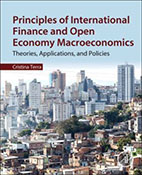Last edition Elsevier Principles of International Finance and Open Economy Macroeconomics: Theories, Applications, and Policies presents a macroeconomic framework for understanding and analyzing the global economy from the perspectives of emerging economies and developing countries. Unlike most macroeconomic textbooks, which typically emphasize issues about developed countries while downplaying issues related to developing countries, this book emphasizes problems in emerging economies, including those in Latin American countries. It also explains recent developments in international finance that are essential to a thorough understanding of the effects and implications of the recent financial crisis.
Last Edition
ISBN 13: 9780128022979
Imprint: Elsevier
Language: English
Authors: Cristina Terra
Pub Date: 06/2015
Pages: 362
Illus: Illustrated
Weight: 610.000 grams
Size: h 191 X 235 mm
Product Type: Softcover
| List Price |
| grn 2818 |
| $ 95,52 |
| to order |
- • Concentrates on developing country perspectives on International Finance and the Economy, including those in Latin American countries
- • Provides case studies and publicly available data allowing readers to explore theories and their applications
- • Explains recent developments in international finance that are essential to a thorough understanding of the effects and implications of the recent financial crisis
- • Proposes a unified mathematical model accessible to those with basic mathematical skills
- Cristina Terra, ESSEC Business School and THEMA, France
- Foreword • Preface o How to Use This Book • Acknowledgments
- • 1. Introduction
- o 1.1 Mathematical Modeling o 1.2 Book Structure
- • Part I: Definitions
- o 2. How to Measure International Transactions
- 2.1 Balance of Payments 2.2 National Accounts 2.3 Balance of Payments Equilibrium 2.4 Open Economy Models Mathematical Appendix 2.5 Exercises
- o 3. The Foreign Exchange Market
- 3.1 The Nominal Exchange Rate 3.2 The Goods and Services Market: The Real Exchange Rate 3.3 The Assets Market: Interest Rate Parity Conditions Mathematical Appendix 3.4 Exercises
- • Part II: Current Account and Real Exchange Rate
- o 4. What Is the Optimum Current-Account Level?
- 4.1 Basic Hypotheses 4.2 Consumption Smoothing 4.3 Comparing with a Closed Economy 4.4 How Economic Shocks Affect the Current Account 4.5 Adding Government 4.6 The Model with Production and Investment 4.7 The Model and the World 4.8 Exercises
- o 5. The Equilibrium Real Exchange Rate
- 5.1 The Real Exchange Rate and the Price of Nontradable Goods 5.2 Production, Consumption, and Equilibrium 5.3 How Does the Real Exchange Rate Respond to Shocks? Mathematical Appendix 5.4 Exercises
- • Part III: Determination of the Nominal Exchange Rate
- Why Different Models?
- o 6. Money and Exchange Rate in the Long Run
- 6.1 Money, Assets, and Goods Markets 6.2 Exchange Rate Fundamentals 6.3 Applications, Extensions, and Limits of the Model Mathematical Appendix 6.4 Exercises
- o 7. Macroeconomic Policies and Exchange Rate in the Short Run
- 7.1 Rigid Prices: The Mundell–Fleming Model 7.2 Sticky Prices: The Mundell–Fleming–Dornbusch Model 7.3 Monetary Models with Price Rigidity: Their Uses and Limitations 7.4 Exercises
- o 8. Portfolio Diversification and Capital Flows
- 8.1 Assets from Different Countries: Imperfect Substitutes 8.2 Gross Capital Flows and Current Account 8.3 Net International Investment Position 8.4 Impact of Shocks on Exchange Rate and Current Account Mathematical Appendix 8.5 Exercises
- • Part IV: Crises and Exchange Rate Policy
- o 9. Currency Crises
- 9.1 The Speculative Attack as Asset Price Arbitrage 9.2 Crises as Self-Fulfilling Prophecies 9.3 The Role of Banks and Foreign Debt 9.4 Contagion 9.5 Exercises
- o 10. Exchange Rate Regimes
- 10.1 Classification of Exchange Rate Regimes 10.2 What Exchange Rate Regime Should Be Chosen? Mathematical Appendix 10.3 Exercises o 11. Political Economy of Exchange Rate Policy 11.1 Distributive Impacts of the Real Exchange Rate 11.2 Exchange Rate as an Indicator of Competence 11.3 The Economic Policy of Fiscal Policy Mathematical Appendix 11.4 Exercises
- • Part V
- o Annexes
- I List of Currencies
- II Data List
- III List of Mathematical Symbols
- o References o Index
- To order a book, you need to send a phone number for a callback. Then specify:
- 1. Correct spelling of the first name, last name, as indicated in the passport or other document proving the identity. (Data is required upon receipt of the order)
- 2. City of delivery
- 3. Nova Poshta office number or desired delivery address.
- The prices on the site do not include the cost of Nova Poshta services.
- When prepaying for the Master Card, the supplier pays the order forwarding.
- Delivery is carried out anywhere in Ukraine.
- Delivery time 1-2 days, if the book is available and 3-4 weeks, if it is necessary to order from the publisher.




